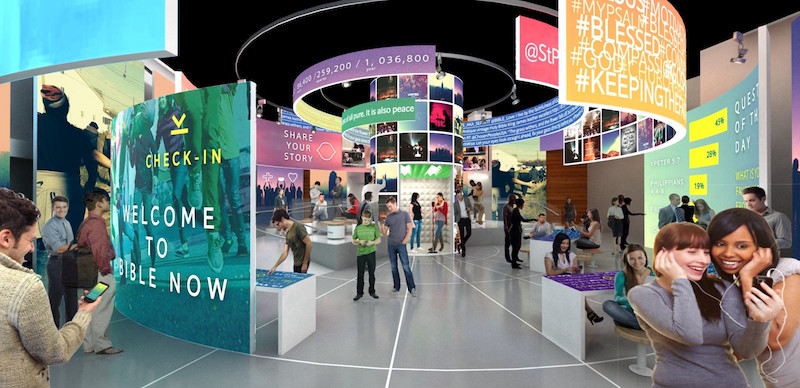The 430,000-sf Museum of the Bible is currently under construction in Washington, D.C., and when completed, will provide visitors with an immersive experience teaching the history, narrative, and impact of the Bible.
The eight-story building will feature 40-foot-tall bronze doors at the main entrance and a garden on the building’s roof. Between the front doors and the garden, the museum will be packed with cutting-edge technology that helps to span time, space, and cultures in teaching the history of the bible.
The first floor will include a gift shop, children’s area, 12,500-sf of temporary exhibition space, permanent library space, and storage space. The second floor will feature research labs and libraries and The Impact of the Bible exhibition. The third floor features The Narratives of the Bible and Nazareth Village exhibitions. On the fourth floor you will find an exhibition named The History of the Bible. Permanent exhibition space, a 500-seat theater, 100-seat lecture hall, classrooms, and offices will be located on the fifth floor. Finally, the sixth floor will feature a gathering room and the Biblical Gardens Restaurant.
The Impact Floor (floor 2) will be highly interactive and use advanced technology to help tell the stories of the impact the Bible has had on the world.
The Narrative Floor (floor 3) intertwines immersive experiences with artifacts as visitors walk through the narratives of the Hebrew text from Genesis to Chronicles, then first-century Nazareth, and finally the New Testament.
The History Floor (floor 4) will feature more than 500 artifacts that document the Bible’s preservation, translation, and transmission across centuries. Some of the artifacts include writings dating to the time of Abraham, fragments of the Dead Sea Scrolls, and early New Testament writings.
The museum is scheduled to open in Fall 2017.
 Rendering courtesy of C&GPartners
Rendering courtesy of C&GPartners
Related Stories
| Aug 11, 2010
Museum celebrates African-American heritage
The Harvey B. Gantt Center for African-American Arts + Culture recently completed construction on the Wells Fargo Cultural Campus in Charlotte, N.C. Designed by the Freelon Group, Durham, N.C., with Batson-Cook's Atlanta office as project manager, the $18.8 million project achieved nearly 100% minority participation.
| Aug 11, 2010
Design for Miami Art Museum triples gallery space
Herzog & de Meuron has completed design development for the Miami Art Museum’s new complex, which will anchor the city’s 29-acre Museum Park, overlooking Biscayne Bay. At 120,000 sf with 32,000 sf of gallery space, the three-story museum will be three times larger than the current facility.
| Aug 11, 2010
Thom Mayne unveils ‘floating cube’ design for the Perot Museum of Nature and Science
Calling it a “living educational tool featuring architecture inspired by nature and science,” Pritzker Prize Laureate Thom Mayne unveiled the schematic designs and building model for the Perot Museum of Nature & Science at Victory Park in Dallas. The $185 million, 180,000-sf structure is 170 feet tall—equivalent to approximately 14 stories—and is conceived as a large...
| Aug 11, 2010
Piano's 'Flying Carpet'
Italian architect Renzo Piano refers to his $294 million, 264,000-sf Modern Wing of the Art Institute of Chicago as a “temple of light.” That's all well and good, but how did Piano and the engineers from London-based Arup create an almost entirely naturally lit interior while still protecting the priceless works of art in the Institute's third-floor galleries from dangerous ultravio...
| Aug 11, 2010
The Art of Reconstruction
The Old Patent Office Building in Washington, D.C., completed in 1867, houses two Smithsonian Institution museums—the National Portrait Gallery and the American Art Museum. Collections include portraits of all U.S. presidents, along with paintings, sculptures, prints, and drawings of numerous historic figures from American history, and the works of more than 7,000 American artists.
| Aug 11, 2010
Silver Award: Please Touch Museum at Memorial Hall Philadelphia, Pa.
Built in 1875 to serve as the art gallery for the Centennial International Exhibition in Fairmount Park, Memorial Hall stands as one of the great civic structures in Philadelphia. The neoclassical building, designed by Fairmount Park Commission engineer Hermann J. Schwarzmann, was one of the first buildings in America to be designed according to the principles of the Beaux Arts movement.







